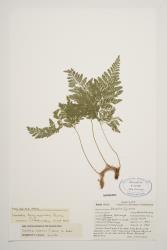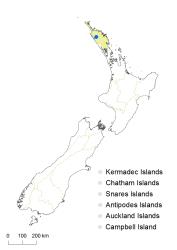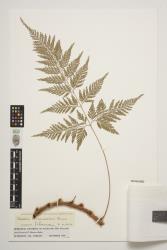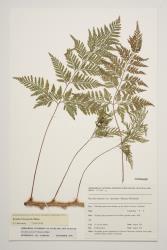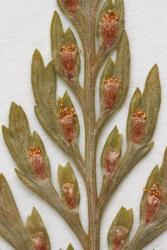- = Davallia mariesii T.Moore ex Baker, Ann. Bot. 5: 201 (1891) nom. illeg., non Davallia mariesii H.J.Veitch 1880
Davallia trichomanoides is known in the wild only from a single juvenile, sterile collection but it also occurs in cultivation. The rhizome scales are very similar to those of D. griffithiana in having marginal setae but lacking the multiseptate hairs of D. tasmanii. Cultivated fronds are generally larger and more divided than in D. griffithiana, usually 4-pinnate rather than 3-pinnate-pinnatifid, and the ultimate segments are narrower. Davallia trichomanoides is most easily distinguished when fertile. The sori are oblong and terminate the veins well inside the pinna margins. The indusia are narrowly oblong and attached at the base and along the whole of both sides, forming deep pouches, 1.2–1.7 mm long, 0.6–0.8 mm wide; the apex is truncate or slightly rounded, ending inside the lamina margin, usually with a lamina tooth on one or both sides.
North Island: Northland
Altitudinal range: 10 m.
Known only from one collection at Rāwene, Hokianga.
Occurs naturally from India and China to Japan and south-east Asia (Nooteboom 1998).
Recorded from a small, sterile patch on an open clay bank under native shrubs as a probable escape from cultivation.
Webb et al. (1995, p. 152, as D. mariesii). Voucher WELT P015795, 1987.
Nooteboom (1994) reduced Davallia mariesii to synonymy under D. trichomanoides but noted that in cultivation it behaved like a good species, and might be best treated as a cultivar with the name ‘Mariesii’.



